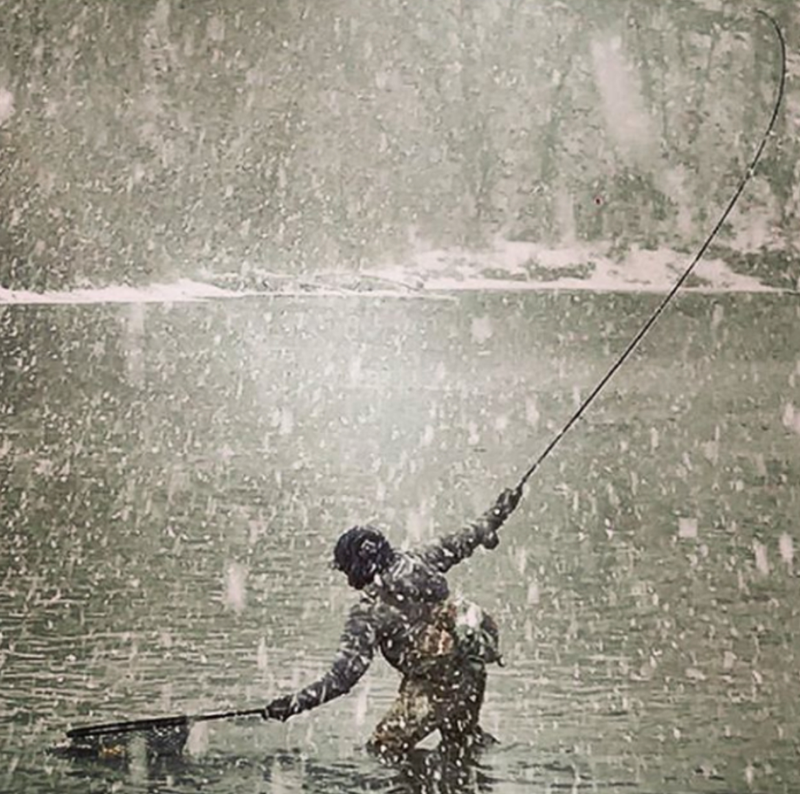For the most part, winter fly fishing calls for microscopic nymphs and the occasional streamer. However, under the right conditions, fishing dry flies can be very productive and frankly, a nice break from the indicator crazies. You know that feeling, your indicator twitches ever so slightly and you set the hook to only find moss on the other end of the line. Then, you repeat that drill until you’ve lost your mind. Well, it doesn’t always have to be that way. Here we’ll discuss some of the intricacies around dry fly fishing in the winter and how to have a productive day on that bone chilling water.

Photo Credit: Dustin Doss @ddoss86
- Only cast to rising trout: This is a great rule to live by year round, but it is particularly important in the winter. If you are not seeing trout actively feeding on the surface, you’re better off nymphing. In the spring, summer and fall, you can easily entice a curious trout with a beefy dry fly, despite no hatch activity, but in the winter, trout are generally sluggish and won’t be tempted to expend the extra energy. Additionally, you're better off targeting multiple trout as opposed to a single riser.
- Hatches require rising water temps: You’re certainly at better odds of stumbling upon a hatch when air temps are comparatively warm. However, it's more about the water temperature. If the average ambient temperature has been below 32 degrees F (freezing point of water) in the last 24 hours, water temperatures will likely be too low to incentivize hatch activity. As far as timing goes, you’re going to want to fish those dries during the warmest parts of the day (10 am to 3 pm) as water temperatures will have had time to warm up and the bug life will be more prominent.
- Changes in weather and barometric pressure: Changes in weather (i.e. cold fronts, warm fronts or changes in barometric pressure) can dramatically shift trout feeding behavior. Changes in air pressure are a signal for trout that inclement weather is on its way and as a result, feed at higher rates in preparation for the storm. During this time, trout will be more inclined to feed on the surface.
- The Midges/BWO Diet: In the winter, midges and BWOs are generally the only flies present on the surface of the water. Midges will hatch year round despite frigid air and water temperatures, but the magnitude of the hatch will be small and brief. BWOs, on the other hand, require slightly warmer water temperatures (+40 deg F) and the hatch will be slightly more aggressive. Just like your nymph patterns, you’re going to want to stick to the smaller flies (#24 and smaller). Go as small as your eyesight can handle and pick out a few Hi-Vis patterns to make it easier on yourself.
- Presentation is key: Trout in the wintertime are especially unforgiving. As such, go with a light fluorocarbon tippet (6X and 7X). Generally, you’re going to want to work with seven to nine feet of leader, but when you’re fishing dries in the winter shoot for 10 to 12 feet to reduce your chances of spooking the trout. Start by casting several feet in front of the trout and let the flies drift down into the strike zone. By doing so, you will give yourself plenty of space between your line and the trout and decrease the odds of spooking it. From there, if you’re not having any luck, try casting a little closer to the trout to see if the surface activity will get its attention and encourage a strike. Presentation is especially difficult in low and slow water and if you’re not seeing any action after a few casts, it’s probably time to move on or switch to a nymph rig.
- Target the tail outs and slow water: In the winter, trout will feed on emerging flies in the slower water near the banks and in the tail outs. Not only is this where hatch activity is most likely to occur, but it makes for great holding water where trout can expend minimal energy and garner the most nutrients.
Fly fishing, particularly in the winter, is a never ending game of cat and mouse. If you can fool a trout on a dry during the coldest part of the year, you can be certain that you can do the same when conditions are more favorable in warmer months. Don't over think it and remember that surface action, timing, location and presentation are the keys to success.
For more on winter fly fishing, come join us on the Blue River in Silverthorne for our inaugural winter fly fishing clinics with owner and head guide of Colorado Trout Hunters Danny Frank.
Clinic Details:
Location: Blue River - Silverthorne
Dates: 1/26/2019, 2/2/2019 & 3/2/2019
Time: 8 am – 1 pm
Cost: $120 per person (includes flies and tippet)
Not Included: Waders, boots, rods, reels or leader
Clinics are limited to 5 anglers per day
Please email danny@coloradotrouthunters.com to reserve your spot!
